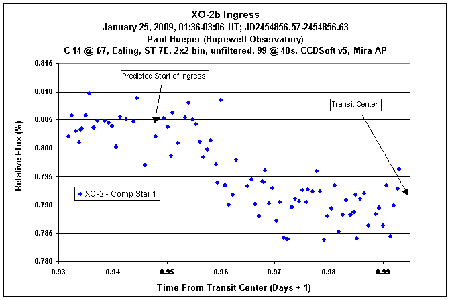EPOXI
Two intriguing investigations -- One flight-proven spacecraft
Gallery
XO-2 Ingress
 Click for full size image.
Click for full size image.
Caption: More than 50 of the 335 extrasolar planets discovered to date are known to transit their host stars from our Earth-based perspective. Many of these transits can be detected by amateur astronomers with the right equipment: a telescope of modest aperture on a mount with very accurate tracking capability, a charge-coupled device (CCD) to make precise measurements of the light from the incoming star, and special computer software to process the CCD's images.
Most extrasolar planet transits last more than two hours and result in a slight dimming of 0.3 to 2.5 percent of the light coming from the host star. Transit observations are challenging because Earth's atmosphere can cause the light to scatter two percent or more, meaning that the light curve from the transit is lost in the noise.
As it appears from Earth, the star XO-2 is fairly faint - about 11th magnitude. It is a K-class dwarf in a binary system located about 475 light years away. This graphic depicts the 1.3% light drop that occurs as the star's single known planet begins to transit the face of the star. This planet, known as XO-2b, has roughly the diameter of Jupiter, but less than 60 percent of its mass. The planet orbits the star in 2.6 days - a very short year!
In addition to being detectable by amateur astronomers, XO-2 is one of handful of stars observed with very high levels of accuracy by the EPOCh project in early 2008. The discovery of much smaller, terrestrial-sized planets orbiting these stars could result after the data from the EPOCh observations is analyzed - a process that is still ongoing.
Credit: Paul Hueper
